The strategic use of AP Inter 1st Year Economics Model Papers and AP Inter 1st Year Economics Question Paper May 2017 allows students to focus on weaker areas for improvement.
AP Inter 1st Year Economics Question Paper May 2017
Note : Read the following instructions carefully :
- Answer ALL the questions as per the choice specified. Draw suitable diagrams wherever necessary.
- Questions from Serial Nos. 1 to 5 in Section ‘A’ are of Long Answer Type. Each question carries TEN marks. ANY THREE questions j may be answered out of five given questions. Every answer may he limited to 40 lines.
- Questions from Serial Nos. 6 to 17 in Section ‘B’ are of Short Answer Type. Each question carries FIVE marks. ANY EIGHT questions may be answered out of twelve given questions. Every answer may be limited to 20 fines.
- Questions from Serial Nos. 18 to 37 in Section ‘C’ are of Very Short Answer Type. Each question carries TWO marks. ANY FIFTEEN questions may be answered out of twenty given questions. Every answer may be limited to 5 fines.
Section – A
Note : Answer ANY THREE out of the following five questions. (3 × 10 = 30)
Question 1.
Explain the law of Diminishing Marginal Utility. What are its limitations?
Answer:
H.H. Gossen was the first economist to explain the law of diminishing marginal utility in 1854. This is also known as “Gossen’s first law”. In 1890 Marshall in his “Principles of economics” developed and popularised this analysis. This law is based on the common experience of every consumer.
This law explains the functional relationship between the stock of a commodity and the marginal utility of that commodity. If a consumer goes on increasing his stock of a thing, additional utility derived from an additional unit declines.
Alfred Marshall’ defines the “Law of diminishing marginal utility” as “The additional benefit which a person derives from a given increase of his stock of a thing diminishes with every increase in the stock that he already has”.
Total Marginal Utility : The want satisfying capacity of a thing is called utility. It can be explained as total utility and marginal utility. Total utility is the sum of the marginal utilities. Total utility tends to be more with larger stock and less with smaller stock.
TUn= f(Qn)
Marginal utility is the additional utility obtained from an additional unit of any commodity consumed.
MUn = TUn – TUn-1
Explanation of the law:
The law of diminishing marginal utility explains the relation between the quantity of good and its marginal utiltiy. If a person goes on increasing his stock of a thing the marginal utility derived from an additional unit declines. The law is clear from the following table.
Total Utility and Marginal Utility Schedule :
| No. of Apples | Total Utility (Utils) | Maarginal Utility (Utils) |
| 1 | 20 | 20 |
| 2 | 35 | 15 |
| 3 | 45 | 10 |
| 4 | 50 | 5 |
| 5 | 50 | 0 |
| 6 | 45 | -5 |
| 7 | 35 | -10 |
In the above table total utility increasing at a diminishing rate till 5th apple and becomes maximum. Marginal utility declining positively till 4th apple and become zero at the 5th apple. From the 6th and 7th apples total utility declines positively and marginal utility becomes negative. Zero marginal utility implies the point of satiety which indicates the complete satisfaction of a given want. Relation between total utility and marginal, utility:
- When total utility increases at a diminishing rate, marginal utility diminishes.
- When total utility is maximum, marginal utility becomes zero.
- When total utility decreases positively, marginal utility becomes negative.
The law of diminishing marginal utility can also be represented diagramatically with the help of the marginal and total utility curves. In the diagram the horizontal axis shows the units of the commodity and vertical axis measures the utility obtained from the units. The T.U.C. represents total utility and M.U.C. represents marginal utility curves.
The T.U.C. curve slopes up-wards from left to right upto point ‘P’ and then slopes downward from left to right. The M.U.C. slopes downwards from left to right. It cuts the X – axis at point ‘N’ when total utility at its maximum. It means the marginal utility is equal to zero, when total utility is at its maximum. If the consumer consumes apples further, the total utility curveT.U.C. falls from point ‘P and slopes downwards from left to right. Therefore M.U.C. is below X- axis after W point. It means the marginal utility is negative.
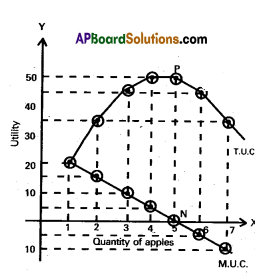
Limitations of the law : There are certain limitations to the law.
- One of the important assumptions of the law is that consumer’s tastes and preferences remains constant. If there is any change in consumer’s habits and preferences this law does not hold good.
- This law is not applicable’for durable goods, as we can . use these commodities for a longer time and measurement ” of utility is not possible.
- In case of complementary goods where we need two or more goods to satisfy a single want this law does not apply.
- If it is not possible to divide the commodity into small units, we can not measure the utility of successive units. So this law is not applicable for indivisible goods.
- Hobbies like stamps and coin collection are an exception to the law of diminishing marginal utility, as the additional units give more satisfaction to the consumer.
![]()
Question 2.
Explain the law of Variable Proportions.
Answer:
The law of variable proportions is also known as the Law of diminishing marginal returns. Economists like Ricardo, Malthus, Marshall gave more importance to this law and propounded their theories by keeping this law as basis. The law of variable propor-tions refers to the short-run. According to the classicals ahd Marshall, this law is applicable to the agricultural sector only. But the modem economists hold that the law is applicable to all the sectors.
The law of variable proportions explains the changes in output when a factor of production is varied while keeping other factors constant in the short period. The law states that if more and more units of variable input is applied to a given quantity of fixed inputs, the total output may initially increases at an increasing rate but beyond a certain level, the rate of increase in the total output diminishes.
According to ‘Marshall’: “An increase in the amount of labour and capital applied in the cultivation of land causes in general, a less than proportionate increase in the amount of output raised unless it happens to coincide with an improvement in the arts of agriculture”.
According to ‘Benham’ : “As the proportion of one factor in a combination of factors is increased, after a certain point. First the marginal and then the average product of that factor will diminish”.
Assumptions of the law:
- The state of technology remains unchanged.
- Input prices remain unchanged.
- It is possible to vary the proportions in which the various inputs are combined.
- All units of the variable factors are homogeneous.
- It is assumed that the’entire operations belongs to short period.
- The product should be measured in physical units.
Explanation of the law:
Let us illustrate the law with the help of table where on the fixed units of land of two acres, units of variable factor are employed keeping other factors constant. The changes in total product, average product and marginal product can be observed in the following schedule. Variable factor(labour) Total product (quintals) Average product (quintals) Marginal product (quintals) Stages
| Variable factor(labour) | Total product (quintals) | Average product (quintals) | Marginal product (quintals) | Stages |
| 1 | 3 | 3 | 3 | I
Increasing returns to stage |
| 2 | 7 | 3.5 | 4 | |
| 3 | 12 | 4 ; | 5 | |
| 4 | 16 | 4 . | 4 | |
| 5 | 19 | 3.8 | 3 | II
Diminishing returns stage |
| 6 | 21 | 3.5 | 2 | |
| 7 | 22 | 3.1 | 1 | |
| 8 | 22 | 2.8 | 0 | III
Negative returns stage |
| 9 | 21 | 2.3 | -1 | |
| 10 | 19 | 1.9 | -2 |
Total production: Sum of the marginal oroductions is called total production. Total product refers to the total output produced per unit of time by all the labours employed.
Average production: It refers to the product per unit of labour. If total product is divided by the number of labourers employed we get average product.
Marginal product: It is the additional product obtained by employing an additional labour.
Marginal product = \(\frac{\Delta \mathrm{TP}}{\Delta \mathrm{L}} \text { i.e., } \frac{\text { Change in total output }}{\text { Change in labour }}\)
Increasing returns:
In the above table total production increasing at increasing rate upto the 4th labourer then the average and marginal production also increasing. At the 4th labourer the average product (4 units) is equal to the marginal product (4 units). This is the ‘First stage’ which is known as the stage of ‘Increasing returns’.
Diminishing returns:
In this stage total production increasing at diminishing rate and becomes to maximum then the average production and marginal productions are diminishing. In the above table at the 8th labourer total production reaches to maximum (22 units) and marginal production becomes to zero. This is the ‘second stage’ which is known as the stage of diminishing returns.
Negative returns:
In this stage total production diminishing positively, average production also but marginal production becomes negative. This is the third stage which is known as the ‘Stage of Negative Returns’
Let us illustrate the law with the help of a diagram. In the diagram TR MP and AP curves inverse, at first reach their maximum and then start declining. The first stage relates to increasing return stage. When more units of labour are applied to a fixed factor, the fixed factor is used more intensively and productivity increases rapidly. This stage is shown in the diagram from O to C. TP, AP and MP are increasing is noted in this stage.
A rational producer will not stop his production in this stage. In the third stage marginal product becomes zero and negative. A rational producer will not undertake production in this stage. This stage starts from point ‘N’. These two stages will not feasable and profitable. Therefore, production will always take place in the second stage but not at the end of the IInd stage because, the MP is equal to zero.

In the I stage MP curve first rises and start falling after reaching maximum. In the n stage AP starts falling. MP and AP are falling but TP is still rising. In the III stage TP, AP and MP are all falling but MP becomes negative.
Importance of the law: This law has several theoretical and practical usages.
- This law is the basis for Malthus population theory of population.
- It is the basis of Ricardian theory of rent.
- It helps to agricultural sector.
- It helps to industrial sector for taking decisions.
![]()
Question 3.
Explain the classification of markets.
Answer:
Market is commonly thought of as a place where commodities are bought and sold and where buyers and sellers meet. But in economics, the word market does not refer to any particular place. It refers to a region. “Market implies the whole area over which buyers and sellers are in such touch with each other, direction or through middlemen, that the price of the commodity in one part influences it in other parts of it”.
Classification of markets: Markets can be classified on the basis of
1) area covered,
2) time and
3) degree of competition.
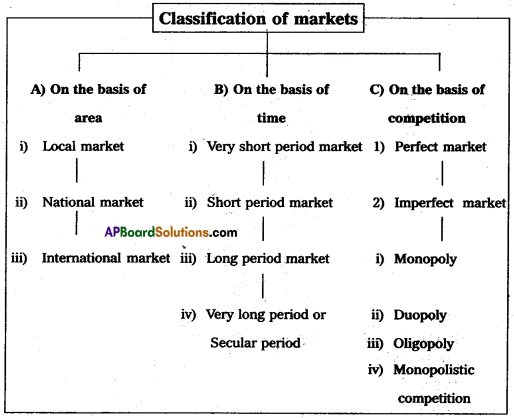
A) On the basis of area : On the basis of area the markets are classified into three.
i) Local market:
A product is said to have local market; when buyers and sellers of the product carry on the business in a particular locality. These goods are highly perishable cannot to take to distant places. They cannot even stored for a longer time. Eg : Vegetables, milk, fruits etq.
ii) National market: A national market is said to exist when a commodity is demanded and supplied all over our country. Generally the market of durable and industrial goods cover the entire nation. Eg: Wheat, sugar, cotton etc.
iii) International market:
International market or world market exists when the buyers and sellers are spread all the world
for a commodity. Eg: Gold, silver, diamonds etc.
B) On the basis of time : Marshall classified these markets into four categories.
i) Very short period market:
The supply is fixed in this market. It may be one day or two days. Perishable goods like fish, vegetables, flowers etc., do have only very short period market. There is no difference between supply and stock of the commodity.
ii) Short period market:
This period is long enough only to change variable factors of production in changing the output. During this period supply can be changed only to some extent, but not totally for a given change in the demand.
iii) Long period market : The long period market is one which is long enough to change the supply totally for a given change in the demand. This period permits to change all the factors of production in changing output. Therefore all factors of production are variable.
vi) Very long period or secular period: This is the period in which ‘the size of population, supplies of rawmaterials, lachs of people etc., would have enough time to change. There is enough time to introduce innovations. In this period changes take place even in the factors of production.
C) On the basis of nature of competition: On the basis of nature of competition, markets are classified into two :
1) Perfect market:
A market is said to be perfect when the competition exists when buyers and sellers are having perfect knowledge about the market conditions. They are large in number. There will only one price for a commodity through out the market etc.
2) Imperfect market:
A market is said to be imperfect when some buyers and sellers both are not aware of the offers being made by others. Buyers and sellers do not have perfect knowledge about the price in different places. Thus price is not uniform throughout the market. It differs from place to place and from seller to seller. Imperfect market can take several forms. They are :
a) Monopoly,
b) Duopoly,
c) Oligopoly and
d) Monopolistic competitions.
a) Monopoly:
Monopoly means a single producer,. Where one producer supplies the commodity to the market. The product supplied by a monopolist will not ha^e close substitutes in the market.
b) Duopoly:
Duopoly is one type of oligopoly market. There are only two producers in the market. They make decisions either independently or together.
c) Oligopoly :
Oligopoly is a market with a few producers. Each firm produces a considerable part of the output. Decisions of one firm affect the other firms.
d) Monopolistic competition: It is a market where several firms produce a commodity with small differences. Firms advertise their goods to promote sales.
![]()
Question 4.
Describe the various methods of redemption of Public Debt.
Answer:
Redemption of public debt means repayment of public debt. All government debts should be rapid promptly. There are various methods of repayment which may be discussed under the following heads.
1) Surplus budget:
Surplus budget means having public revenue in excess of public expenditure. If the government plans for a surplus budget, the excess revenue may be utilized to repay public debt.
2) Refunding:
Refunding implies the issue of fresh bands and securities by government so that the matured loans can be used for repayment of public debt.
3) Annuities:
By this method, the government repays past of the public debt every year. Such annual payments are made regularly till the debt is completely cleared.
4) Sinking fund:
By this method, the government creates a separate fund called ‘Sinking fund’ for the purpose of repaying public debt. This is considered as the best method of redemption.
5) Conversion:
Conversion means that the existing loans are changed into new loans before the date of their maturity.
6) Additional taxation:
Government may resort to additional taxation so as to raise necessary funds to repay public debt under this method new taxes are imposed.
7) Capital levy:
Capital levy is a heavy one time tax on the capital assets and estates.
8) Surplus Balance of payments :
This is useful to repay external debt for which foreign exchange is required surplus balance of payment implies exports in excess of imports by which reserves of foreign exchange can be created.
Question 5.
Explain various methods of calculating National Income.
Answer:
The concept of National Income did hot receive much atten¬tion from the economists until the great economic depression of thirties. National Income is determined by the volume of employment. J.M. Keynes brought out the importance of National Income and employment in economic theory to achieve rapid economic devel¬opment The study of National Income is important.
“National Income or National dividend is the flow of goods and services produced and made available to the people in a country in a year”. National Income may be interpreted in Three ways :
- The total value of output in a country in a year,
- The total value of all incomes received by the owners of factors of production in a year,
- The total expenditure incurred on all goods and services in a year.
According to ‘Marshall’ :
“The labour and capital of a country, acting upon its natural resources produce annually a certain net aggregate of commodities, material and immaterial including services of all kinds.
According to ‘Pigou’:
“The national dividend is that part of the objective income of the community including of course, income derived from abroad which can be measured in money”.
According to Irving Fisher: “The National dividend or income consists solely of services as received by ultimate consumers : whether, from their material or from their human environments”.
Methods of measuring National Income : There are three methods of measuring National Income. They are
- Net output method or Value added method,
- Income method and
- Expenditure method.
1. Product Method or Output Method: GNP is total value of final goods and services produced in a year. The final goods are valued at market prices, whether sold or added on inventories. Gross National Product (GNP) is always stated in money term. No item should be counted twice. To avoid double counting we exclude raw materials and intermediate goods. Eg: We include the value of bread only but not include the value of flour which used to make bread.
2. Income Received or Income Method :
We added the income received by individuals and other for the services rendered by them in production. The total incomes of the factors of produc¬tion put together is the National Income. The following precautions are to be taken, in estimating National Income.
- Exclude all transfer payments like old age pensions, interests etc.
- Exclude all illegal incomes and wind fall gains.
- Value of production for self-consumption and imputed rent of owner occupied houses.
- Incomes divided from the sale of second hand goods shall not be included.
- We should not count any income twice. Eg : The profits distributed by companies will be included in incomes of the shareholders. So it shall not be included in the incomes of companies.
3. Expenditure Method: This process of adding up expen-diture on all final goods is called the expenditure approach. The Gross National Product is divided into four component parts according to who buys the goods and services,
- Goods and services bought by consumers;
- Investment goods purchased by business houses;
- A combination of consumer and investment goods pur-chased by government and
- Net exports (Value of exports minus value of imports) to foreign countries. It is the aggregate value of current production of goods and services flowing to the consumer business houses, government and foreign countries.
Section – B
Note : Answer ANY THREE out of the following five twelve question (8 × 5 = 40)
Question 6.
Discuss wealth definition.
Answer:
Adam Smith was the first person to give a precise definition of Economics and separate this study from other social sciences. Adam Smith is considered as ‘Father of Economics’. He defined it in his famous book Wealth of Nations’, as “An enquiry into the nature and causes of wealth of nations”. Most of the economics in the 19th century held this view.
J.B. Say states that “The aim of political economy is to show the way in which wealth is produced, distributed and consumed”. The other economists who supported this definition are J.B. Say, J.S. Mill, Walker .and others.
The main features of Wealth definition :
- Acquisition of wealth is considered as the main objective of human activity.
- Wealth means material things.
- Human beings are guided by self-interest, whose objective is to accumulate more and more wealth.
Criticism :
The wealth definition was severely criticised by many writers due to its defects.
- Economists like Carlyled and Ruskin pointed out that economics must discuss ordinary man’s activities. So they called it as a ‘Dismal Science’.
- Adam Smith’s definition, wealth was considered to consist of only material things and services are not included. Due to this the scope of economics is limited.
- Marshall pointed out wealth is only a means to an end but
not an end in itself. - This definition concentrated mainly on the production side and neglected distri-buted side.
Question 7.
What are the characteristic features of wants?
Answer:
Wants are the starting point of all economic activities. As social conditions improve, people prefer not only to satisfy their basic needs but also to have comforts and luxuries. So if one want is satisfied, the other crops up. If there are no wants, there is no consumption, no production, no exchange, no distribution etc.
Characteristic features of human wants: Human wants are not uniform or similar. They differ from person to person, time to time and place to place. Wants are having the following characteristic features.
1) Wants are unlimited: Human wants are unlimited. There is no end to human wants. When want is satisfied another want takes its place. A person who has no cycle would like to have it in the first instance, latter scooter, car etc. ‘
2) A particular want is satiable:
Although a man cannot satisfy all his wants, a particular want can be satisfied completely in a period of time. It is possible because the intensity of wants is limited. Eg: Want for T.V can be satisfied by purchasing a T.V An important law in economics known as the law of Diminishing Marginal Utility is based on this characteristic.
3) Wants are competitive:
Human wants are unlimited. But the means to satisfy them are limited of scarce. Hence it is possible for us to satisfy some wants only and leave the rest. So, every want completes with other to get satisfied:
4) Wants are complementary:
To satisfy a particular want we need a group of commodities at the same time. In other words, satisfaction of a single want requires the simultaneous consumption of a number of commodities. Eg: To satisfy the want for coffee we need milk, sugar, decoction etc. a ,y :
5) Wants are alternative:
Most of our wants can be satisfied by different ways. For example : we can satisfy our hunger either by taking meal or bread or fruits or milk etc. Thus particular want can be satisfied by several alternatives.
6) Wants are recur:
Many of the human wants are recur. They appear again and again although they satisfied completely in a particular time period. Eg: If we feel hungry, we take some food and satisfy this want. But after some time we shall again feel hungry.
7) Wants differ in urgency:
All our wants are not equally important or urgent. They differ greatly in intensify. Some wants are more urgent and other are less urgent.
![]()
Question 8.
Write the properties of Indifference Curves.
Answer:
Indifference curve shows the various combinations of two commodities which yield equal utility or satisfaction to the con-sumer.
Indifference schedule:
According to A.L. Meyers “An indifference schedule may be defined as schedule of various combi¬nations of goods that will be equally satisfactory to the individual concerned”. This can be explained with the help of a table and diagram.
| Combinations | Number of x | Number of y |
| A | 1 | 20 |
| B | 2 | 15 |
| C | 3 | 11 |
| D | 4 | 8 |
| E | 5 | 6 |
| F | 6 | 5 |
In the above schedule the consumer gets as much total satisfaction from combination A and as well as from other combinations B, C, D, E and F, the total satisfaction is seeme’in all these combinations. Since consumer get same satisfaction he is indifferent to select any one of the combinations. Therefore this may be called “weak ordering”
Indifference curve:
With the help of the above table we can draw an indifferent curve to study its properties. In the side diagram ‘X’ good are shown on ‘OX’ axis ; and V good shown on ‘OY’ axis.

IC is the indifferent curve. A, B, C, D, E, and, F are the various combinations of X and Y. The points on indifference curves give the consumer the equal level of satisfaction of various points is the same that is A = B = C = D = E = F.
Properties of indifference curves : The important properties of Indifference curve are
- Indifference curves slopes downwards from left to right there exists negative slope.
- Higher indifference curve represent higher levels of satisfaction. Indifference curve to the right represents high satisfaction.
- The indifference curves can never meet or intersect each other.
- The indifference curves are convex to the origin.
- Indifference curves need not be parallel to each other.
Question 9.
Explain the exceptions of the law of demand.
Answer:
In Economics demand means a desire which is backed up by ability to buy and willingness to pay the price. Thus demand will be always at a price and time. According to Marshall ‘The amount demanded increases with a fall in price and disminishes with rise in price when other things remain the same”.
Exceptions: In certain situations, more will be demanded at higher price and less will be demanded at a lower price. In such cases the demand curve slopes upward from left to right which is called an exceptional demand curve. This can be shown in the fol-lowing diagram.
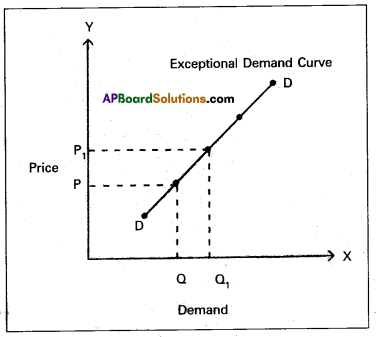
In the diagram when price increases from OP to OP1, demand also increases from OQ to OQ1. This is opposite to law of demand.
1) Giffen’s Paradox:
This was stated by Sir Robert Giffen. He observed that poor people will demand more of inferior goods, if their prices raise. Inferior goods are known as Giffen goods. Eg : Ragee, Jowar etc. He pointed out that in case of the English workers, the law of demand does not apply to bread. Giffen ‘ noticed that workers spend a major portion of their income on bread and only small portion on meat. ‘
2) Veblen Effect (Prestigious goods):
This exception was stated by Veblen. Costly goods like diamonds and precious stones are called prestige goods or veblen goods. Generally rich people purchase those goods for the sake of prestige. Hence rich people may buy more such goods when their prices rise.
3) Speculation:
When the price of a commodity rises the group of speculators expect that it will rise still further. Therefore, they buy more of that commodity. If they expect that there is a fall in price, the demand may not expand. Eg : Shares in the stock market.
4) Illusion:
Some times, consumer develop to false idea that a high priced good will have a better quality instead of low priced good. If the price of such good falls, demand decreases, which is contrary to the law of demand.
Question 10.
Explain the point method of measuring.Price Elasticity of Demand.
Answer:
Point method: This method is introduced by Marshall. In this method elasticity of demand is measured at a point on the demand curve. So this method is also called as geometrical method. In this method to measure elasticity at a point on demand curve the following formula is applied.
Ed = \(\frac{The distance from the point to the x – axis}{\sqrt{The distance from the point to the y – axis }}\)
In the below diagram, AE is straight line demand curve. Which is 10 cm. length. Applying the formula we get
Ed = 1, Ed < 1, Ed = 0
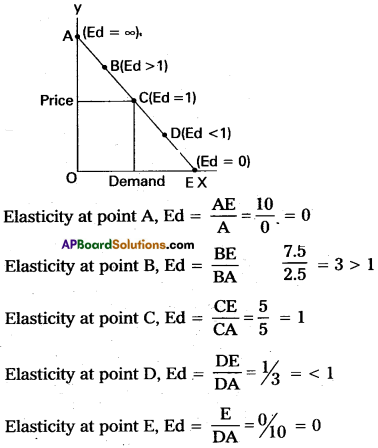
If the demand curve is non¬linear. It means if the demand curve is not straight line will be drawn at the point on the demand curve where to measure elasticity. In the diagram at C point where Elasticity of demand will be equal to \(\frac{\mathrm{CB}}{\mathrm{CA}}\) .
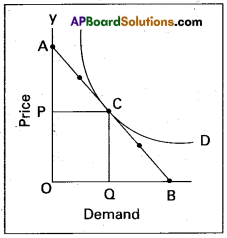
Question 11.
Explain the concept of Scarcity Rent.
Answer:
Marshall explained the concept of scarcity of rent on the basis of demand and supply. In general land has indirect demand or derived demand. If there is an explosion of population demand for land increases this result rise in its price. The surplus earned by land above its price is called scarcity rent. The supply of land is fixed and inelastic. The demand for land will determine the rent by influencing its price. Hence rent arises due to the scarcity in the supply of factors of production.
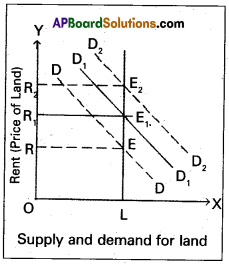
In the side diagram on ‘OX’ axis represent supply and demand for land. ‘OY’ axis represents Rent. SL is supply of land. It is perfectly inelastic when ‘DD’ curve shifts upward to D1 D1So price increases from OR to OR1 Similarly if demand curve further shifts from D1D1 to D2D2 rent pried further increases from OR1 to OR2.
![]()
Question 12.
What are the factors that determine National Income?
Answer:
The concept of National Income occupies an important place in economic theory. National Income is the flow of goods and services which become available to a nation during a year. Factor determining National Income: There are a number of influences which determine the size of the National Income in a country.
1) Quantity and quality of factors of production :
The quantity and quality of land, climate, rainfall etc., determining the quality and quantity of agricultural output in any country. Hence it determines the size of National Income. The quantity of labour increases the productivity of the nation. Mineral resources can raise the industrial production. The qualitative and quantitative capital stock has the greatest influence on total output. National Income depends on physical capital and human capital also.
2) The state of technology:
A country with a poor technical knowledge cannot have a large sized national output or dividend. Because it will not be in a position to make the best possible use of its resources.
3) Entrepreneurial ability:
The quality and quantity of entrepreneurial ability is also an important element to determine the size of National Income of a country. The availability of resources along with efficient allocation of them determines the level of National Income.
4) Political stability: Political stability is an essential pre-requisite for maintaining production at the highest level; The economic development of several countries, particularly the South American Republics has been hindered in the past by political instability.
Question 13.
Explain the concept of effective demand.
Answer:
Effective demand means where aggregate demand equals the aggregate supply. When aggregate demand is equal to aggregate supply the economy is in equilibrium. This can be shown in the table.
| Level of employment | Aggregate supply price | Aggregate demand price |
| 10 | 500 | 600 |
| 11 | 550 | 625 |
| 12 | 600 | 650 |
| 13 | 650 | 675 |
| 14 | 700 | 700 AD = AS |
| 15 | 750 | 725 |
| 16 | 800 | 750 |
In the above table when the level of employment is 14 lakh workers, aggregate demand price is equal to aggregate supply price i.e ₹ 700 crores. This can be shown in the following diagram..
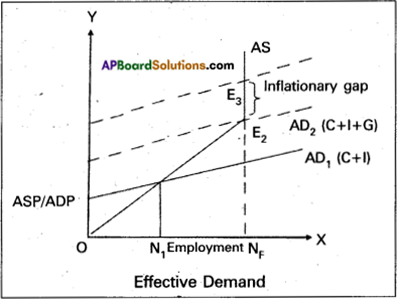
In the above diagram aggregate demand price curve (AD) and the aggregate. Supply price curve (AS) interest each other at point Er It shows the equilibrium point. The equilibrium has been attained at ON, level of employment. It is assumed that ON} in the above diagram does not indicate full employment as the economy is having idle factors of production. So it is considered as underemployment equilibrium.
According to Keynes, to achieve full employment an upward shift of aggregate demand curve is required. This can be possible through government expenditure on goods and services supplied in the economy, whenever private entrepreneurs may not show interest to invest. With this the AD1 curve (C + I) shift as AD2 (C + I + G) at new point of effective demand E2, where the economy reaches full employment level i.e., ONF.
Question 14.
What are the sources of Public Revenue?
Answer:
Public revenue is an important concept in public finance. It referes to the income of the government from different sources. Dalton in his “Principles of Public Finance” mentioned two kinds of public revenue. Public revenue includes income from taxes, prices of goods and services of public enterprises, revenue from administrative activities such as fees, fines etc., and gifts and grants.
Sources of Public Revenue: Broadly speaking, government receives revenue it from five different Sources namely :
- Taxes
- Commercial
- Administrative revenue
- Grants
- Gifts.
These different sources of public revenue may be explained as follows :
1) Taxes:
Taxes are the first and foremost source of public revenue. Taxes are compulsory payments to government without expecting direct benefit or return by the tax payer.
2) Commercial Revenue:
Commercial revenue imply the incomes received by government from public enterprise by selling their goods and services. They are obtained by the government in the form of price of goods and services. Income from electricity, auction of liquor sale, railway services, oil, sterl, mines, forests etc.
3) Administrative Revenue:
These includes fees, licences, fires, forfeitures and special assessments. They are collected from those individuals who get benefits. As these arises due to the efforts of administrative personnel, they are described as administrative revenue.
4) Grants:
Grants are received by a country from other countries. The local and provincial governments with in a country receive grants-in-aid from Central Government for performing certain functions. The Central Government gives gram – in – aid on conditional or unconditional basis. The grants received by the government of a country from the governments of other countries are known as foreign aid. Especially grants are highly useful for the underdeveloped countries is achieving economic development.
5) Gifts:
Gifts comprise the cost important spurce of public revenue. They refer to the voluntary contribution from individuals or institutions to the government at different levels. Individuals denote liberally in times of war, famine, cyclone etc.
![]()
Question 15.
State the objectives of Central Bank.
Answer:
Reserve Bank of India is the central bank of India. It was established in April 1935, with a share capital of ₹ 5 crores. It was originally owned by private shareholders and was nationalised by the government of India in 1949. It performs all the functions of central bank according to the “Reserve Bank of India Act 1934”. The main objectives of Reserve Bank of India are :
- Regulating the issue of currency notes.
- Providing guidance to the commercial banks.
- Controlling the credit system of the economy.
- Achieving the monetary stability in the economy.
- Implementing the uniform credit policy throughout the country.
Question 16.
Enumerate the measures for control inflation.
Answer:
To control the inflation the Government has taken various steps. They are:
- Increase the production in the long-run.
- Implementing proper monetary and fiscal policies to reduce the supply of money and credit.
- Controlling prices and eliminating black markets.
- Importing the goods which are scares in supply from outside countries.
- Introducing rationing and quota system in case of mass consumption of goods.
- Distribution of goods to all the needy sections of the people.
Question 17.
Calculate the “MEDIAN” of the following data:
| Class Interval | Frequency | Ct |
| 0-10 | 5 | 5 |
| 10-20 | 10 | 15 |
| 20-30 | 25 | 40 |
| 30-40 | 30 | 70 |
| 40-50 | 20 | 90 |
| 50 -60 | 30 | 100 |
Answer:

Section – C
Note : Answer ANY EIGHT out of the following twelve question (15 × 2 = 30)
Question 18.
Economic goods.
Answer:
Economic goods are man made. They have cost of production and price. They are limited in supply. They have both value in use and value in exchange. Eg : Pen, Book etc. Economic goods are also called scarce goods.
Question 19.
Price
Answer:
The value of a commodity expressed in terms of money is known as price. The price of anything is its value measured in terms of a standard money value. Ex : A pen is exchanged for 10 rupees than the price of that pen is 10 rupees.
Question 20.
Cardinal utility
Answer:
Alfred Marshall developed cardinal utility analysis. According to this analysis the utilities derived from consumption of different commodities can be measured in terms of arbitary units called utils. 1, 2, 3, 4 are called cardinal numbers.
Question 21.
Cross Demand
Answer:
Cross demand refers to the relationship between any two goods which are either complementary to each other or substitute of each other at different prices. Dx = f(Py).
Question 22.
Price elasticity of demand.
Answer:
It was developed by marshall. It relates to the responsiveness of quantity of commodity demanded to the change in its price, Ep = \(\frac{Pr oportinate change in demand }{\sqrt{proportinate change in price}}\)
![]()
Question 23.
Production function
Answer:
Production function is technical concept. It represents functional relationship between inputs and the amount of output produced.
Gx = f(L, K, R, N, T)
Question 24.
Monopoly.
Answer:
Mono means single, Poly means seller. In this market single seller and there is no close substitutes. The monopolist is a price maker.
Question 25.
Price discrimation.
Answer:
Price is determined in the market with total demand and total supply. In the perfect competition at equilibrium price an infinite quantity is sold.
Question 26.
Contract Rent
Answer:
It is the hire charges for any durable good. Ex : cycle rent, room rent etc. It is a periodic payment made for the use of any material good. The amount paid by the tenant cultivator to the landlord annually may be also called contract rent. Ex : The rent that a tenant pays to the house owner monthly as per an agreement made earlier or the hiring charges of a cycle ₹ 10 per hour is also contract rent.
Question 27.
Net Interest.
Answer:
Net interest is the reward for the service of the capital loan. Ex : Net interest paid on government bonds and government loAnswer:
Question 28.
Per Capita Income.
Answer:
National income when divided by countries population.
Per capita income = \(\frac{National income}{\sqrt{total population}}\)
The average standards of living of country is indicated by per capita income.
Question 29.
Full employment.
Answer:
Full empolymertt is a situation in which all those who are willing to work at the existing wage rate are engaged in work. The classical economists opened that full empolyment is the normal situation in the economy.
Question 30.
Deficit budget.
Answer:
Deficit budget arises when the total expenditure in the bud¬get exceeds the total receipts in the budget.
![]()
Question 31.
Currency.
Answer:
Currency consists of paper notes and coins paper notes are issued by the government or the central bank of a country. In india the reserve bank which is the central bank of india issue currency notes at all denominations except one rupee notes. The government of india issue them coins are metallic tokens and are produced in the mints of government.
Question 32.
Near money
Answer:
The near money refers to those highly liquid assets which are not accepted as money but then can be easily converted into money within a short period. Ex : Saving bank deposit, shares, treasury bills, bonds etc.
Question 33.
Hyperinflation.
Answer:
Hyper inflation is also known as galloping inflation. If the inflation rate exceeds 10% per annum is called Hyper inflation. The rate of inflation may go upto 100% or even more. This is highly dangerous and totally upsets the economy.
Question 34.
Find the A.M. for the data 30, 20,32, 16, 27.
Answer:
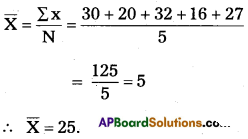
Question 35.
What is Pie diagram?
Answer:
This diagram enables us to show the partitioning of total into component parts. It is also called a pie chart. Ex : Draw the pie diagram for following data.

Total area = 16 + 24 + 10 + 8 + 5 = 63
Area changed into Degrees =
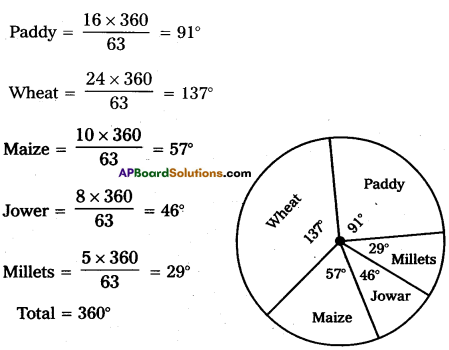
Question 36.
Overdraft
Answer:
Over draft is permissable on current account only. The current account holders are given the facility of overdrafts by which they are allowed to draw on amount above their balances. However they can overdraw the amount upto a certain limit fixed by the bank.
Question 37.
Find the MODE for the data 12, 11, 15, 12, 9, 12, 7.
Answer:
Mode is “12” because it is occuring in no. of times. That is 3 times.